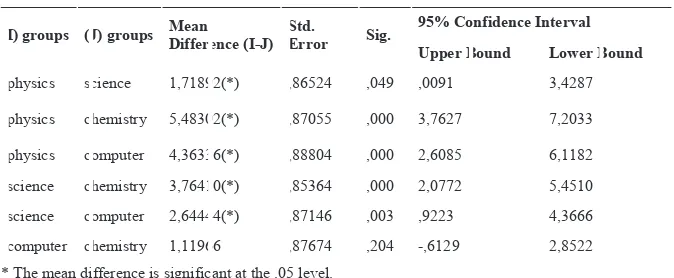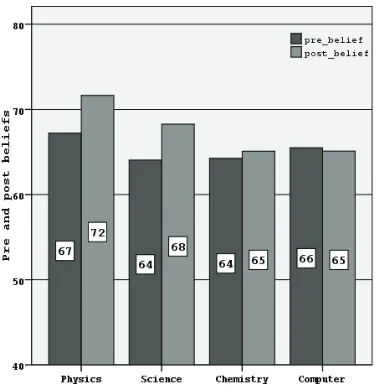1877-0428 © 2010 Published by Elsevier Ltd. doi:10.1016/j.sbspro.2010.03.735
Procedia Social and Behavioral Sciences 2 (2010) 4587–4591
The effect of computer simulations over students’ beliefs on physics
and physics success
Ersin Bozkurt
a*, Aslan Ilik
aaAhmet Kelesoglu Education Faculty, Selcuk University, Konya, 42090, Turkey
Received November 5, 2009; revised December 8, 2009; accepted January 20, 2010
Abstract
The purpose of this study is to measure the impact of teaching which is carried out with interactive computer simulations on students’ beliefs about physics and achievement of physics. The research has been carried out in 2008-2009 academic year fall semester at Selcuk University Ahmet Keleúo÷lu Education Faculty on 152 students who studied General Physics 1 Course. For the study a survey called “Colorado Learning Attitudes about Science Survey” (CLASS) was used. In addition a success test has been used to measure students’ success on Physics. As a result of analysis data obtained from the research, it was seen that the courses with interactive simulations have a positive effect on students’ beliefs about physics and physics achievement.
Keywords: Physics education; computer based learning; computer simulations; studens’ attitude; learning environment.
1. Introduction
Since the emergence of microcomputers, educators and researchers have been trying to explore and develop uses of computers in classrooms and create new application areas. Today, in most universities computers are used in the field of physics education. Computers offer many presentations and opportunities to facilitate lectures in large-scale classrooms. In addition, computers create study environment allowing students to study individually and encourage them. One of the most important use areas of computers in physics education is that, when applied in laboratory experiments and on difficult concepts related to the teaching of physics, it gives the opportunity of straightforward teaching. What is more, data in experiments can be collected using computers as aids in laboratories and this data can be displayed simultaneously and analyzed. Apart from collecting data, one of the important use areas of computer is the education and training process run by simulations (Sokoloff, & Thornton, 1997; Steinberg, Oberem, & McDermott, 1996; Zacharia, & Anderson, 2003). With the help of a powerful simulation many of physics subjects which are difficult to teach and transfer can be made simpler and clearer. Also, some experiments which are difficult to make or hard for the students to understand in a real laboratory can be made much simpler with the help of simulations. In this way physics courses are becoming a fun and immersive. This affects students’ thoughts about physics and their courage significantly. Many computer simulations prepared nowadays allow students to learn physics concepts and let them have manual skills in virtual environments that can only be acquired in real laboratories. Many researches have shown that they are more successful in courses run by these simulations
Ersin Bozkurt. Tel.: +90-332-323-8220; fax: +90-332-323-8225
E-mail address: [email protected]
© 2010 Elsevier Ltd. Open access under CC BY-NC-ND license.
departments lessons were run by computer simulations. For simulations it has been benefited from Java and Flash simulations prepared by PHET (2008) group. In Figure 1 pictures of some used simulations were given. To determine the success of the groups multiple choice achievement test consisting of 20 questions was used. For the reliability of the test Į coefficient was calculated as 0.87. Achievement test were applied to groups before and after application. Collected data was compared with pre and post test achievements. In addition, to determine the groups’ beliefs on physics and physics learning before application, five-grade Likert type scale (CLASS) consisting of thirty eight items was used (Adams, Perkins, Podolefsky, Dubson, M., Finkelstein, & Wieman, 2006). The scale has five sub-dimensions. They are respectively the conceptual understanding (conceptual physics has a structure), mathematics and physics relationship (equations represent the concept), to understand / strain (I do efforts to understand physics), real-world relationship (physics explain world events) and personal interests (physics has an important place in our lives). Survey as in achievement test was distributed before and after application and students’ pre and post beliefs were determined. For each dimension the percentages of the points were calculated over groups’ expected responses. Calculating the differences of these beliefs before and after the application, improvements in the groups’ beliefs were observed. Obtained data is presented in the graph. Looking at the correlations between groups’ beliefs and their achievement test gains, it was searched that what kind of effect different teaching techniques have on the relation between students’ beliefs and success.
The moving man Energy skate park
Figure1: A representation of the simulations used in the study (PHET, 2008)
3. Findings and Comments
Figure 2: Average pre and post achievement test scores of the groups Table 1: Anova analysis of pre-achievement test of the groups
Sum of
Squares df
Mean
Square F Sig.
Between Groups 39,785 3 13,262 1,665 ,177 Within Groups 1178,530 148 7,963
Total 1218,316 151
The Anova analysis comparing post-achievement test scores of the groups is as in table 2. According to the table there is a significant difference between average post-achievement test scores of the groups (F3-148=16.314, P<0.05).
Table 2: Anova analysis of post-achievement test of the groups
Sum of Squares df Mean Square F Sig.
Between Groups 704,259 3 234,753 16,314 ,000 Within Groups 2129,635 148 14,389
Total 2833,895 151
Anova LSD results determining between which groups the differences are as in table 3. As can be seen in the table physics and science groups who studied with simulations are more successful than chemistry and computer groups who studied with traditional methods (P<0.05).
Table 3: Anova LSD results of post-achievement test of the groups
95% Confidence Interval I) groups (J) groups Mean
Difference (I-J) Std.
Error Sig.
Upper Bound Lower Bound
studied with simulations. Especially, while positive increase has been seen in the experimental groups on conceptual understanding level beliefs, decrease has been seen in control groups who studied with traditional methods. Decrease has been observed on the beliefs about sub-dimensions with real world relation of the students in chemistry group. Almost every sub-dimensions of experimental group developed more attitude compared to control group. The survey results of pre and post beliefs (overall) of groups are as in table 3.
Figure 3: Pre and post beliefs of the groups (overall)
The correlation showing the relation between the differences of average pre and post test points and the differences of pre and post beliefs is as in Table 5. When the relation between success gains and belief increase is considered on the table, it can be seen that physics and science groups who studied with computer simulations have positive and significant relation (p<0.05).
Table 5: The correlation between achievement gains and beliefs of the groups
Gain of beliefs Gain of achivement test
Gain Std. Error Gain Std. Error
Pearson correlation P
4. Conclusions and Recommendations
According to our analysis, it has been seen that the groups who study with computer simulations are more successful than those who study with traditional methods. In addition, the analysis that we have made regarding beliefs of the groups show that the teaching methods play a role on students' beliefs. According to the analysis results, it can be seen that there is a positive relation between the beliefs and achievements of the groups. These results are thought to stem from the teaching method with computer simulations. In addition, in the analysis of the beliefs of groups, a better growth is observed about the sub-dimensions of the survey on the experimental group students' “conceptual understanding”. At this stage a decrease in the students of control group were observed. Also, a decrease has been observed on the beliefs of “real world connection” stage for the students of chemistry group consisting control group. These our results are supported by a similar study. In their study, Perkins et al. (2004) observed positive correlations between student beliefs and conceptual learning gains, and said that students who come into a course with more favorable beliefs are more likely to achieve high learning gains (Perkins, Adams, Finkelstein, Pollock, & Wieman, 2004). According to these results, we can say that essential environmental conditions should be supplied for the application of such a method which has both got effect on students’ beliefs about physics and their success. Furthermore, we believe that traditional methods and single straight channel teaching methods should be avoided as soon as possible.
References
Adams, W. K., Perkins, K. K., Podolefsky, N. S., Dubson, M., Finkelstein, N. D., and Wieman, C. E. (2006). New instrument for measuring student beliefs about physics and learning physics:The Colorado Learning Attitudes about Science Survey. Physical Review Special Topics - Physics Education Research 2, 010101.
Baily, C., & Finkelstein, N.D. (2009). Development of quantum perspectives in modern physics. Physical Review Special Topics - Physics Education Research 5, 010106.
Finkelstein, N. D., Perkins, K. K., Adams, W., Kohl, P., & Podolefsky, N. (2004). Can computer simulations replace real equipment in undergraduate laboratories?. In Physics Education Research Conference Proceedings, doi:10.1063/1.2084701.
Halloun, I. A. (2001). Student views about science a comparative survey A Monograph. Published By Educational Research Center, Lebanese University, Beirut, Lebanon.
Elby, A. (2001). Helping physics students learn how to learn. American Journal of Physics , 69, 54-64.
Perkins, K. K., Adams, W. K., Finkelstein, N. D., Pollock, S. J., & Wieman, C. E. (2004). Correlating student beliefs with student learning using the Colorado learning attitudes about science survey. In Physics Education Research Conference Proceedings; doi:10.1063/1.2084701. Phet. (2008). Interactive simulations of The Physics Education Technology Project (PHET). Retrieved June 8, 2008, from
http://phet.colorado.edu/index.php
Redish, E.F., Saul, J.M., & Steinberg, R.N. (1998). Student expectations in introductory physics. American Journal of Physics, 66, 212-224. Skoloff, D.R., & Thornton, R.K. (1997). Using active lecture demonstrations to create an active learning environment. The Physics Teacher, 35,
340-346
Steinberg, R.N., Oberem, G.E. & McDermott, L.C. (1996). Development of a computer-based tutorial on the photoelectric effect. American Journal of Physics , Volume 64, Issue 11, 1370-1379.

